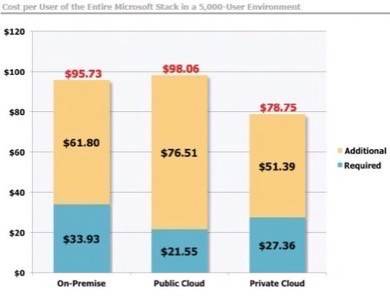The typical wisdom around Microsoft’s platform strategy during the past three years has been that the company is desperate to move its existing server software product customers to a cloud-based model in order to retain those customers amid growing competition. A research report from Osterman released this morning throws icy cold water on that theory. Indeed, the research team has found through direct calculation that the reason Microsoft wants to move enterprise server customers to the cloud is because that’s where the payoff is.

Using a model of a 5,000-user enterprise based around Microsoft’s three principal communications platforms – Exchange, SharePoint and Lync (sometimes called the Unified Communications stack), during 36 months of simulated licensed use, the Osterman team found the following: Of three possible configurations – conventional on-premise, private cloud and public cloud – it is the private cloud option that is the least expensive for the enterprise.
The takeaway here is that the savings that small organizations receive by going with public cloud deployments – which Osterman confirms remain sizable – do not scale up for bigger companies.
“While public cloud providers include a variety of hardware, switching, storage, license fees and other features in the base price of their offerings,” the Osterman report reads, “this base price is significantly higher than the fully amortized price of the hardware, software and other infrastructure elements offered in a private cloud deployment.” The report was sponsored by Azaleos, which incidentally is a managed services provider in its own right, including hybrid deployments of UC services.
[Chart credit: Osterman Research]

When deploying Microsoft Exchange, the Osterman team discovered that enterprises pay 26% less during a 36-month period for a private cloud-based deployment than for licensing Microsoft’s hosted Exchange service in its public cloud. They also pay 16% less for private cloud than for traditional on-premise installations. Osterman makes clear that on-premise installations, under its definition, are managed entirely in-house, while private cloud installations allow for co-location and (incidentally) managed service providers.
The gap is still sizable, but reduced somewhat when all three UC components are taken into account. Enterprises spend 10% on private cloud deployments of Exchange, SharePoint and Lync than for Microsoft’s comparable hosted Office 365 services, and 16% less than for on-premise deployments of all three, during a 36-month period. That’s the typical period now for many businesses’ requisitioning cycles – no longer the four- or five-year cycle that was common in the previous decade.
The clincher for large businesses, Osterman Research found, is all the extra costs they have to incur to upgrade what are essentially small business-class services – costs that accrue monthly. Office 365 licensing is the cheaper way to go for SMBs. But Microsoft offers its O365 licenses as upgrades to its lower tiers, which enterprises still pay for.
So in the Exchange licensing model, a per-seat/per-month license for Hosted Exchange with all the necessary features (like migration assistance and help desk support) costs $6.28, while the standard Software Assurance licensing fees for a private cloud deployment of Exchange costs $8.45. But once enterprise-class services are added, and the E2 tier license gets upgraded to E3, the public cloud license costs $27.81 per-seat/per-month versus $20.51 for a comparable private cloud Exchange deployment.
The phenomenon does not translate to all three of Microsoft’s UC components. SharePoint’s cheapest licensing model is the public cloud option, Osterman found, costing a total of $31.96 per-user/per-month for 5,000 users for Hosted SharePoint versus $34.74 for a private cloud installation. However, the study points out, that gap can be more than compensated for by opting to exclude the backup site for disaster recovery.
The firm also concedes that price savings for on-premise deployments – the most expensive option in any case – can perhaps be found by systems designers who plan for resource sharing, rather than siloing the UC components among separate servers. Still, the findings contradict the conventional wisdom that public-cloud based pricing is just as upwardly scalable as the deployments themselves.

















